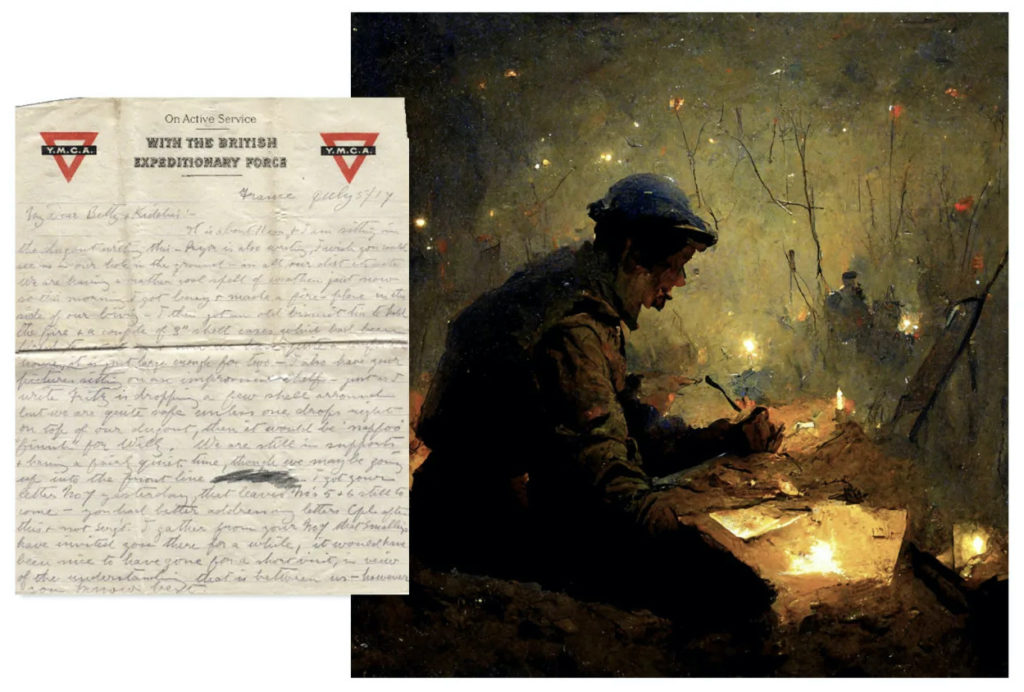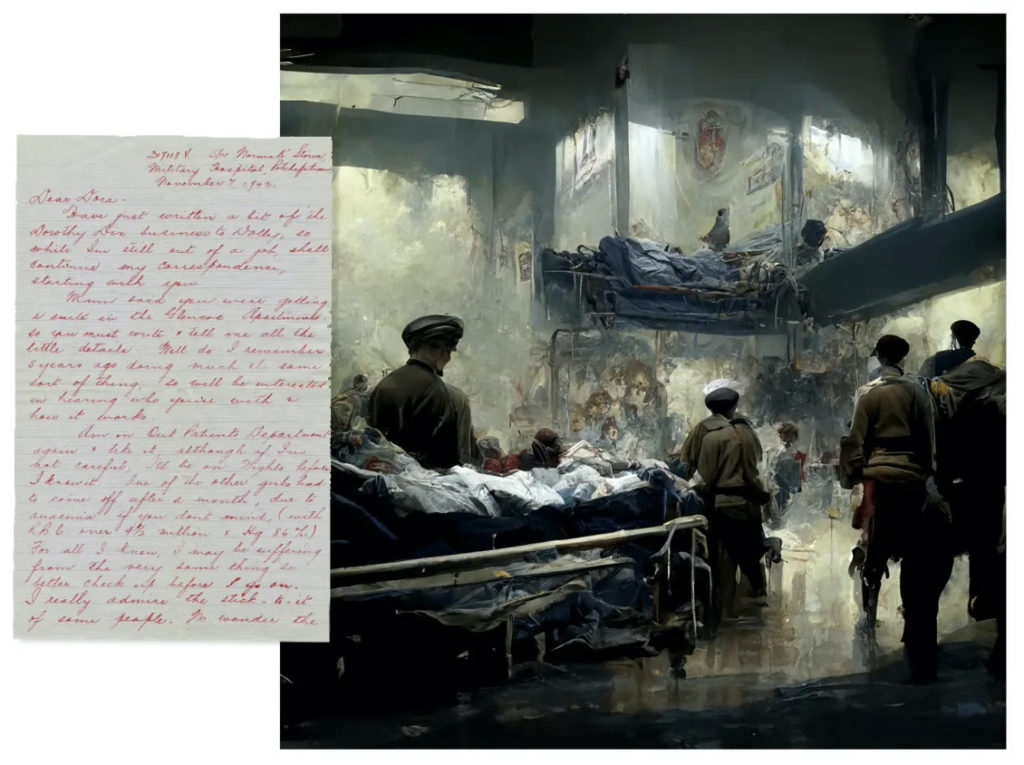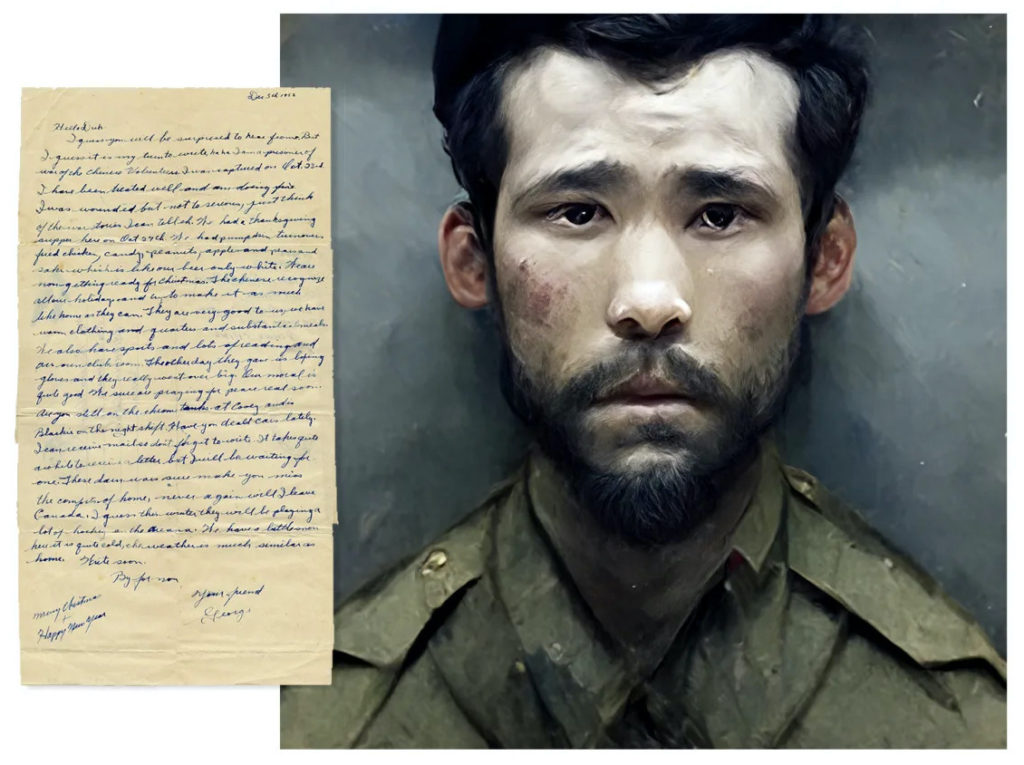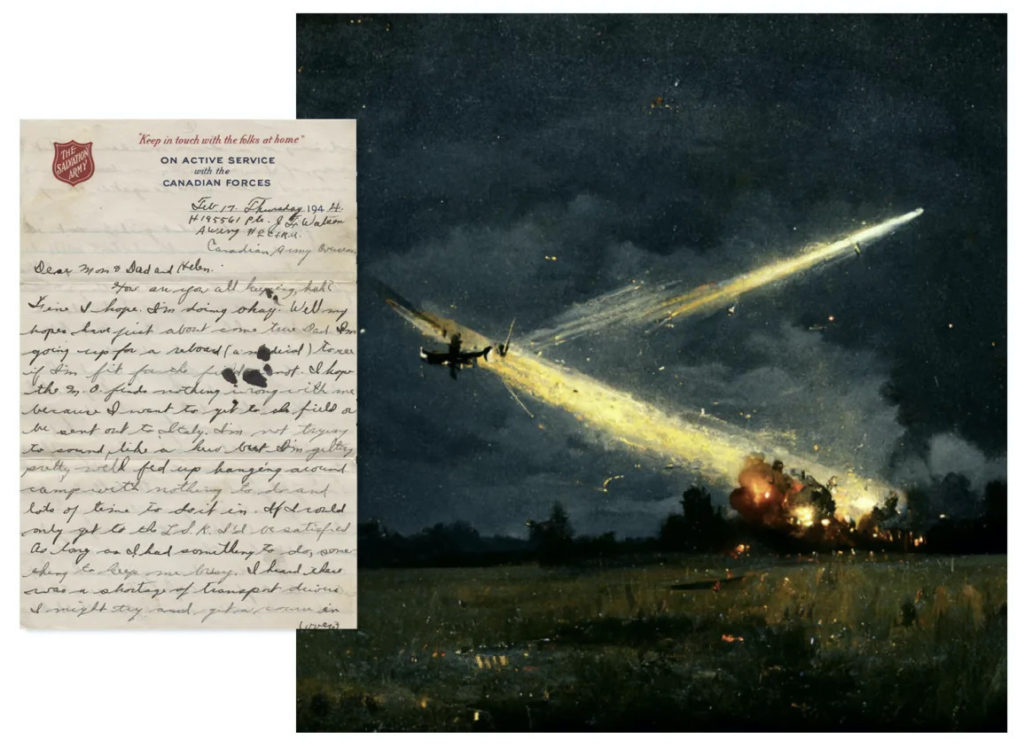Inside True Patriots Love Foundation and Wunderman Thompson’s evocative project
In 1944, as World War II raged, Royal Canadian Air Force pilot Gordon Gibson wrote a letter home describing his aerial view of D-Day and the Allied landing at Normandy:
“Their shells rocked the coast like a tree in a hurricane. The whole area was covered in a pall of yellow-black smoke. The sky was aglow with fire and death.”
That stirring first-person account, and those of six other Canadian veterans, inform “Remastered Memories,” an A.I. art project from Toronto-based charity True Patriot Love Foundation. Image generator Midjourney analyzed key phrases from vets’ letters to create haunting oil-on-canvas-style digital artwork for billboards, print ads and online messages.
Gibson’s descriptions inspired an almost impressionistic rendering of sand and surf lit by explosions from mortars and grenades. Wrecked landing craft poke through the flames like sad sentinels. Human forms trudging through the foam and crawling on land are few and far between—dimly-glimpsed chessboard figures prepared to make the ultimate sacrifice:
A pilot describes Normandy on D-Day in a letter written just two days after the historic event. Read the original letter written by Gordon Gibson, 1944.
“Using artificial intelligence allowed us to turn the author of the letter into the artist, removing any human interpretation other than their own,” says Ari Elkouby, CCO at Wunderman Thompson, which developed the campaign for Remembrance Week in Canada. “It’s the closest we could get to showing works of art that were created by the soldiers’ themselves, which we believe captures a more personal and authentic version of each memory.”
The debate rages about the increasingly significant role A.I. plays for agencies and brands. Recent projects from Nestlé, Heinz and Campfire CD Steve Coulson—plus Wunderman’s “Smallpox Simulator” for Meridian—have pushed boundaries, as pundits mull if such tech augurs the death or renaissance of marketing creativity. In “Remastered Memories,” we see a true collaboration, with the human-machine interface crafting dynamic, deeply felt takes on history.
For example, a heightened sense of mood and emotion permeates an illustration based on a letter by World War I Army infantryman James Hepburn. He lost an arm, and was writing from a French hospital with his other hand for the first time. Note how a crimson-haze wafts over the casualty ward, reminding us that for some fighters, the cloud of war never dissipates:
A wounded soldier in a French hospital describes losing his arm in a letter to his father. Written by James Hepburn, 1917.
“A handful of key words and phrases were selected from each letter and entered into the algorithm,” Elkouby says. “As the letters were often several pages long, we searched for words that provided a visual description of what was happening in the scenes, as well as words they used to describe the emotions they were feeling at the time. To help guide the algorithm markers such as ‘WWI,’ ‘D-Day,’ or the year the letters were written were added.”
Next, George Stonefish, an indigenous solider, describes his sense of isolation during a European deployment in 1917:
“I still see the green leaf and a green grass…[I am] still looking at the same moon as the people at home looking at. Still, I am here…the friends which I came with are all gone.”
The A.I. interpretation of such lines offers an intriguing contrast with the Gibson piece above, where the G.I.s appear dwarfed by the fiery conflict. Stonefish’s letter generated a markedly different take on the wartime experience. A solitary figure, crowned by moonlight, dominates the frame. He stares into the distance, a cypher for every serviceman or woman grappling with violent reality and an uncertain future:
An Indigenous soldier reflects on looking up at the same moon as the people at home thousands of miles away in a letter to his friend. Written by George Stonefish, 1917.
“For many Canadians, Remembrance Week is losing its importance. Younger generations do not understand the impact of war on those who serve and on our country as a whole,” says True Patriot Love CEO Nick Booth. “There are over 461,000 Veterans in Canada. Many may be isolated or need our help. This unique campaign creates powerful visual representations of real experiences, allowing us all to see what the world looked like through the eyes of someone who served.”
This project video offers additional insight:
True Patriot Love plans to expand the collection soon. The organization will ultimately together with Canon 3-D print the pieces for auctions supporting veterans’ physical rehabilitation and mental health programs, easing their transition back to civilian life.
You can see the other four A.I. efforts below, from dispatches by soldier William Mayse, nurse Norma Stowe, POW George Griffiths and trooper James Francis Watson:

A soldier in the trenches details the shell-torn ground and blood-red poppies in a letter to his wife and children. Read the original letter written by William Mayse, 1917.

A five-star nurse talks about treating an air crash victim who’s still in his flight suit in a letter home to her sister. Written by Norma Stowe, 1943.

A prisoner of war in Korea describes missing home during the holidays in a letter to his friend. Written by George Griffiths, 1952.

A soldier recounts experiencing his very first air raid in a letter to his parents and sister. Read the original letter written by James Francis Watson, 1944.
This article was published before by David Gianatasio for Muse by Clio.










